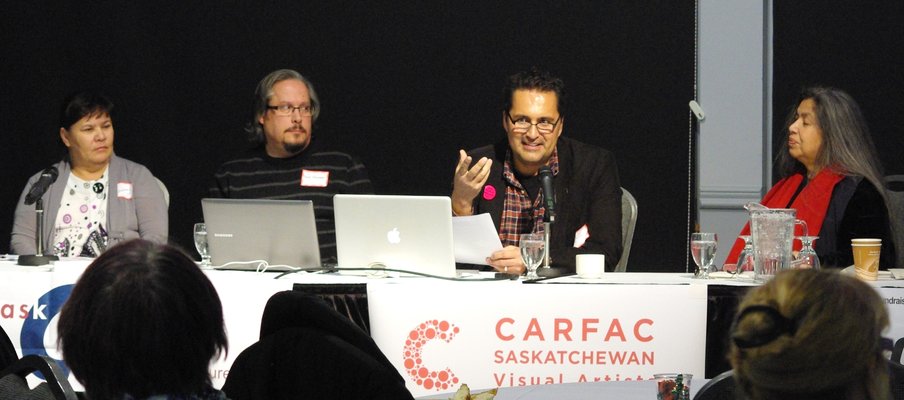
CARFAC bridges gap with Aboriginal artists
In this issue
 Engage - Volume 4, Issue 2, Winter 2014
Engage - Volume 4, Issue 2, Winter 2014
Related Programs
Several years ago, CARFAC Saskatchewan (Canadian Artists’ Representation/le Front Des Artistes Canadiens) identified a gap in terms of its service to, and engagement with, the Aboriginal artist community. While there were already existing initiatives in place at CARFAC to support artist initiatives, there was limited contact with Aboriginal artists who would benefit from them. So, CARFAC went to work to address the gap.
Since 2009, CARFAC has been working on the development of a document entitled Industry Standards/Best Practices, Aboriginal Arts. CARFAC Saskatchewan is a cultural non-profit organization that is tasked to improve the status and wellbeing of Saskatchewan visual artists through research, public education, service and advocacy.
In 2009, CARFAC engaged Aboriginal Arts and Culture leader, Audrey Dreaver, a member of the Mistawasis First Nation, to reach out and visit nine communities from across Saskatchewan to obtain the input of Aboriginal artists across the province. This input was focused on the importance of copyright, cultural exchange, marketing and the diversity of art practice amongst First Nations and Métis people. These meetings resulted in a document, Industry Standards/Best Practices, Aboriginal Arts. A series of outreach and community engagement initiatives began to occur through partnerships with community organizations, and Dreaver had extensive experience in the cultural sector as an independent curator, art instructor and exhibit consultant with local First Nations communities in both urban and rural settings.
Dreaver says, “We pulled together a committee, which included Mary Longman, Leah Dorian, and Robin Brass, to ensure that the statements were captured. Across all interviews, a common statement emerged. All artists said, ‘there should be a gathering, if not every year, than every other year, to learn from each other. To learn techniques. To talk about common issues’.” Through these interviews, a picture began to emerge of areas that needed to be addressed. “All those words (in the Industry Standards/Best Practices, Aboriginal Arts draft document), are direct comments from the people that were interviewed,” adds Dreaver.
One of the issues that required more discussion was ‘cultural appropriation’, which is the unilateral decision to use someone else’s imagery without permission, in visual arts. CARFAC opened this up for discussion with two panels in both Saskatoon in May 2013, at CARFAC’s AGM, and more recently in Regina at the First Nations University in November 2013. The panelists presented on the topics of cultural appropriation, from examples of Colonial paintings of ages past that became accepted ‘realities’ of who native people are, to ongoing examples in present day Saskatchewan that contribute to the broader populations misunderstanding of Aboriginal people, and ultimately, the inaccurate depiction and portrayal of Aboriginal identity. Dreaver explains how it was helpful, because “non-Aboriginal people began to understand what we are talking about.”
Having achieved some initial success in these endeavors, CARFAC has continued to pursue one of the more ambitious aspects of the feedback they received from the community consultations. In May 2014, this multi-year, community-based work will come together as an Aboriginal Artist symposium in Saskatoon.
“This idea is to bridge youth with the Aboriginal artists in attendance and hopefully build a connection that will be impactful on the Oskayak (young people) students,” says Dreaver. She also hopes to include students as part of the symposium. “It will start their connection to the artists and the content of the Industry Standards/ Best Practices, Aboriginal Arts document. Artists from all over the province will talk about art, learn about art, learn new things, and industry standards and (ultimately) to ratify as a community the words of the artists presented in 2009.”
CARFAC wishes to acknowledge the following partners: Oskayak High school, CARFAC National, Tribe Inc., Indigenous Peoples Arts Collective of Prince Albert, Common Weal Community Arts Inc., First Nations university of Canada’s Indian Fine Arts Department, City of Saskatoon, the Saskatchewan Craft Council, Mann Art Gallery and SaskCulture/ Saskatchewan Lotteries for funding assistance through the Aboriginal Arts and Cultural Leadership Grant.

